
Yacht racing is a sailing sport involving sailing yachts and larger sailboats, as distinguished from dinghy racing, which involves open boats. It is composed of multiple yachts, in direct competition, racing around a course marked by buoys or other fixed navigational devices or racing longer distances across open water from point-to-point. It can involve a series of races with buoy racing or multiple legs when point-to-point racing.

The metacentric height (GM) is a measurement of the initial static stability of a floating body. It is calculated as the distance between the centre of gravity of a ship and its metacentre. A larger metacentric height implies greater initial stability against overturning. The metacentric height also influences the natural period of rolling of a hull, with very large metacentric heights being associated with shorter periods of roll which are uncomfortable for passengers. Hence, a sufficiently, but not excessively, high metacentric height is considered ideal for passenger ships.

The Fastnet Race is a biennial offshore yacht race organized by the Royal Ocean Racing Club (RORC) of the United Kingdom with the assistance of the Royal Yacht Squadron in Cowes and the City of Cherbourg in France.
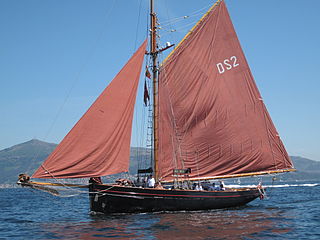
Jolie Brise is a gaff-rigged pilot cutter built and launched by the Albert Paumelle Yard in Le Havre in 1913 to a design by Alexandre Pâris. After a short career as a pilot boat, owing to steam replacing sail, she became a fishing boat, a racing yacht and a sail training vessel.

The Chicago Yacht Club Race to Mackinac is a 333-mile annual yacht race starting in Lake Michigan off Chicago, Illinois, and ending in Lake Huron off Mackinac Island, Michigan. It is hosted and managed by the Chicago Yacht Club. The "Mac" was first run in 1898 and is the oldest annual freshwater distance race in the world. The race hosts several hundred competitors each year and over 3,000 sailors.

Capsizing or keeling over occurs when a boat or ship is rolled on its side or further by wave action, instability or wind force beyond the angle of positive static stability or it is upside down in the water. The act of recovering a vessel from a capsize is called righting. Capsize may result from broaching, knockdown, loss of stability due to cargo shifting or flooding, or in high speed boats, from turning too fast.

In sailing, a boom is a spar (pole), along the foot of a fore and aft rigged sail, that greatly improves control of the angle and shape of the sail. The primary action of the boom is to keep the foot flatter when the sail angle is away from the centerline of the boat. The boom also serves as an attachment point for more sophisticated control lines. Because of the improved sail control it is rare to find a non-headsail without a boom, but lateen sails, for instance, are loose-footed. In some modern applications, the sail is rolled up into the boom for storage or reefing.

In sailing, hiking is the action of moving the crew's body weight as far to windward (upwind) as possible, in order to decrease the extent the boat heels. By moving the crew's weight to windward, the moment of that force around the boat's center of buoyancy is increased. This opposes the heeling movement of the wind pushing sideways against the boat's sails. It is usually done by leaning over the edge of the boat as it heels. Some boats are fitted with equipment such as hiking straps and trapezes to make hiking more effective.
The International Offshore Rule (IOR) was a measurement rule for racing sailboats. The IOR evolved from the Cruising Club of America (CCA) rule for racer/cruisers and the Royal Ocean Racing Club (RORC) rule.
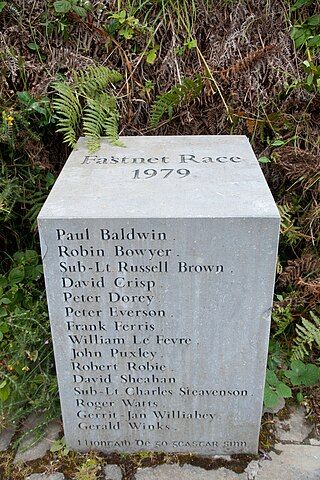
The 1979 Fastnet Race was the 28th Royal Ocean Racing Club's Fastnet Race, a yachting race held generally every two years since 1925 on a 605-mile course from Cowes direct to the Fastnet Rock and then to Plymouth via south of the Isles of Scilly. In 1979, it was the climax of the five-race Admiral's Cup competition, as it had been since 1957.
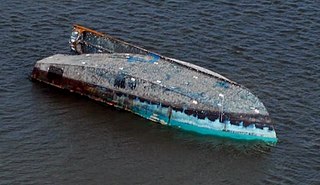
In dinghy sailing, a boat is said to be turtling or to turn turtle when the boat is fully inverted with the mast pointing down to the lake bottom, riverbed, or seabed. The name stems from the appearance of the upside-down boat, similar to the carapace of a sea turtle. The term can be applied to any vessel; turning turtle is less frequent but more dangerous on ships than on smaller boats. It is rarer but more hazardous for multihulls than for monohulls, because multihulls are harder to flip in both directions. Measures can be taken to prevent a capsize from becoming a turtle.
Olin James Stephens II was an American yacht designer. Stephens was born in New York City, but spent his summers with his brother Rod, learning to sail on the New England coast. He also attended the Massachusetts Institute of Technology for a term.

The Contessa 32 is a 9.75 metre (32 ft) fibreglass monohull sailing yacht, designed in 1970 by David Sadler in collaboration with yachtbuilder Jeremy Rogers, as a larger alternative to the Contessa 26. With over 750 hulls built, the yacht has become the most successful one-design cruiser-racer of all time. The yachts have a masthead sloop rig, with a fin keel and a skeg-mounted rudder, a cutting edge concept for the period which now represents a cross between newer and older designs.

A sailing yacht, is a leisure craft that uses sails as its primary means of propulsion. A yacht may be a sail or power vessel used for pleasure, cruising, or racing. There is no standard definition, so the term applies here to sailing vessels that have a cabin with amenities that accommodate overnight use. To be termed a "yacht", as opposed to a "boat", such a vessel is likely to be at least 33 feet (10 m) in length and have been judged to have good aesthetic qualities. Sailboats that do not accommodate overnight use or are smaller than 30 feet (9.1 m) are not universally called yachts. Sailing yachts in excess of 130 feet (40 m) are generally considered to be superyachts.
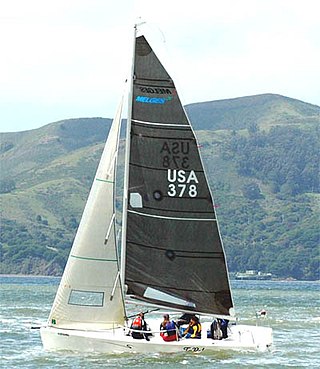
The term sportsboat first appeared in the late 1980s and early 1990s to describe trailer sailers that were optimised for high performance at the expense of accommodation and ballast. The very definition of the term "sportsboat" is evolving.
The capsize screening formula (CSF) is a controversial method of establishing the ability of boats to resist capsizing. It is defined for sailboats as: Beam / ( 1/3), with Displacement measured in pounds, and Beam in feet. A lower figure supposedly indicates greater stability, however the calculation does not consider factors such as hull shape or ballast.

The 1993 Sydney to Hobart Yacht Race, sponsored by Kodak, was the 49th annual running of the Australian "blue water classic" Sydney to Hobart Yacht Race. It was hosted by the Cruising Yacht Club of Australia based in Sydney.

John Pierce Rousmaniere is an American writer and author of 30 historical. technical, and instructional books on sailing, yachting history, New York history, business history, and the histories of clubs, businesses, and other organizations. An authority on seamanship and boating safety, he has conducted tests of equipment and sailing skills and led or participated in fact-finding inquiries into boating accidents. He has been presented with several awards for his writing and his contributions to boating safety and seamanship.
The following outline is provided as an overview of and topical guide to sailing:
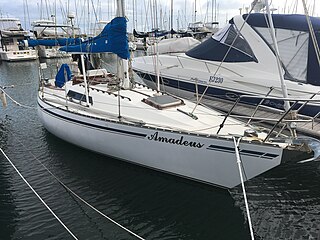
UFO 34 is a cruising and racing fibreglass monohull sailboat class. It is a sloop based on a design by Holman and Pye. The design features a spade rudder and a Bermuda rig with a large, overlapping headsail. Over 150 UFO 34s have been built both in the United Kingdom and Australia.